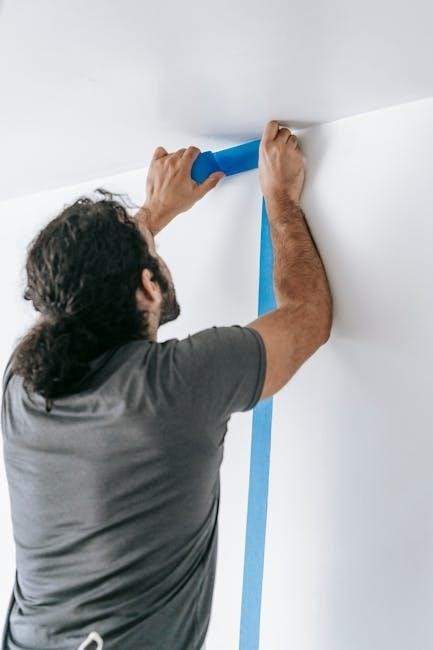Choosing the right bat size is crucial for optimal performance and comfort. This guide helps players of all levels find the perfect bat length, weight, and drop.
Understanding Bat Measurements
Bat measurements include length, weight, and drop, crucial for determining the right fit. Understanding these elements helps players optimize performance and comfort during gameplay.
2.1 How Bat Length is Measured
Bat length is measured from the knob to the end of the barrel in inches. Proper length ensures control and swing efficiency, with various methods like arm extension or chest-to-fingertip measurement helping determine the ideal size for each player.
2.2 What is Bat Drop?
Bat drop is the difference between the bat’s length in inches and its weight in ounces. A higher drop indicates a lighter bat, enhancing swing speed, while a lower drop suits stronger players seeking more power. Proper drop selection balances performance and personal preference.
Factors Influencing Bat Size
Age, height, weight, strength, and swing type are key factors in determining the ideal bat size, ensuring optimal performance and comfort for players of all levels.
3.1 Age Groups
Different age groups require specific bat sizes to accommodate growth and skill levels. Youth players (4-12 years) start with smaller bats, while teens and adults use longer, heavier options. Proper sizing ensures comfort and performance, adapting to physical development and strength increases over time.
3.2 Height and Weight
A player’s height and weight significantly influence bat size. Taller players may need longer bats, while lighter players prefer lighter options. Balancing these factors ensures optimal swing mechanics and control, allowing for maximum performance and comfort during play.
3.3 Strength and Swing Type
A player’s strength and swing type greatly influence bat selection. Stronger players may prefer a lower drop for more power, while lighter bats suit those with faster swings. Matching bat weight to swing mechanics enhances performance and ensures optimal results during games.

Choosing the Right Bat Weight and Drop
Selecting the ideal bat weight and drop involves balancing length and power. A higher drop means a lighter bat, suitable for younger players, while lower drops offer more weight for stronger hitters. Proper fit ensures better swing mechanics and performance, tailoring to individual strength and hitting style.
League and Certification Requirements
Ensure your bat meets league standards: BBCOR for high school/college, USSSA for travel leagues, and USA for youth. Each certification has specific performance and safety requirements.
5.1 BBCOR Certification
BBCOR certification is required for high school and college play, ensuring bats meet strict performance standards. These bats have a drop of -3 and are designed for advanced players, balancing swing speed and power while maintaining safety and fair play standards.
5.2 USSSA Certification
USSSA certification is designed for travel and youth leagues, offering higher performance bats with larger sweet spots. These bats typically feature drops ranging from -5 to -14, catering to younger players who need lighter options to generate faster swing speeds and improve overall hitting performance effectively.
5.3 USA Bat Certification
USA Bat Certification is designed for younger players, ensuring safer, more balanced performance. Bats must meet strict standards, including a max drop of -10, to reduce exit speed. This certification is common in pre-high school leagues, promoting a level playing field and better skill development for young athletes across the nation.
How to Test the Fit of a Bat
To ensure proper fit, extend your arm horizontally and hold the bat; if it feels balanced, it’s a good length. Stand the bat beside you and reach for the handle—if your palm reaches it comfortably, the size is appropriate. These methods help confirm the bat’s suitability for your height and strength, ensuring optimal performance and comfort during play.
Proper bat sizing is essential for optimal performance and comfort. By considering age, height, weight, and strength, players can make informed decisions. Remember to test the fit and ensure league certification. With the right bat, players can confidently step onto the field, ready to succeed and enjoy the game to the fullest.
Choosing the right bat size is essential for performance and comfort. Factors like age, height, weight, strength, and swing style determine the ideal bat length and weight. This guide helps players and parents select the perfect bat, ensuring compliance with league certifications and optimizing gameplay potential.
Bat length is measured in inches, while drop is the difference between length and weight in ounces. A 30-inch bat weighing 20 oz has a -10 drop.
2.1 Length
Bat length is measured in inches, typically ranging from 24 to 34 inches. Proper length ensures comfort and control, with methods like measuring from chest to fingertips or placing the knob in the palm to determine fit. This ensures optimal performance and reach for players of all ages and skill levels.
2.2 Drop
Bat drop is the difference between a bat’s length (in inches) and its weight (in ounces). A higher drop means a lighter bat, allowing for faster swings. For example, a 30-inch bat weighing 20 ounces has a -10 drop. Lighter bats suit contact hitters, while heavier options favor power hitters.

Factors Influencing Size
Age, height, weight, strength, and swing style are key factors in determining bat size. These elements help ensure the bat is appropriately sized for a player’s build and hitting style.
3.1 Age
A player’s age significantly impacts bat sizing. Youth bats typically require higher drops for lighter weights, aiding younger players in generating bat speed. As players mature, they often transition to heavier bats with lower drops, enhancing power and control.
3.2 Height/Weight
A player’s height and weight influence bat size, as taller or heavier players may require longer or heavier bats for optimal performance. Proper sizing ensures comfort and control, allowing players to swing efficiently and maintain balance during their swing.
3.3 Strength/Swing
A player’s strength and swing type significantly impact bat selection. Stronger players may prefer heavier bats for more power, while lighter bats suit those with faster swing speeds. Swing style, whether for power or contact, also influences the ideal bat weight and drop, ensuring optimal performance and comfort.

Choosing Weight and Drop
Choosing the right bat weight and drop involves balancing power and control. Higher drops (-8 to -14) suit younger players needing lighter bats, while lower drops (-3 to -7) are for stronger hitters seeking more power. Consider your strength, swing speed, and hitting style to find the optimal weight and drop combination.
League Requirements
Ensure your bat meets league standards, as certifications like BBCOR, USSSA, and USA dictate allowable drops and weights for different age groups and levels of play.
5.1 BBCOR
BBCOR (Bat-Ball Coefficient of Restitution) certification is required for high school and college leagues, ensuring bats meet performance standards. BBCOR bats are made from aluminum, composite, or wood, with a -3 drop. A visible certification stamp is mandatory, except for one-piece wood bats. This standard promotes fair play and safety.
5.2 USSSA
USSSA certification is designed for travel and youth leagues, offering higher performance bats. USSSA bats typically feature a drop range of -5 to -13, catering to younger players. They are popular in competitive tournaments and are allowed in leagues that accept USSSA standards, providing a balance of power and control for developing hitters.
5.3 USA
USA certification focuses on youth players, ensuring safer, more balanced bats. Introduced in 2018, USA bats offer higher drops for lighter swings. They are approved for pre-high school leagues. This certification prioritizes performance and safety, making it ideal for younger athletes aiming to improve their batting technique and overall game performance effectively.
Testing Fit
To ensure proper fit, extend your arm horizontally and measure from your chest to fingertips for length. Stand tall with the bat beside you; the knob should reach your palm. Additionally, place the bat’s end on the ground and extend your reach—the barrel should be within your grasp for optimal comfort and performance.
Selecting the right bat involves understanding measurements, personal preferences, and league rules. By following sizing guides and testing methods, players can find a bat that enhances performance, ensuring confidence and success on the field for every swing.
Proper bat sizing is essential for performance and comfort. Understanding measurements like length, weight, and drop ensures a perfect fit. League requirements and personal preferences also play a role. This guide helps players of all levels find the ideal bat, maximizing their potential on the field through informed choices.

Understanding Measurements
Key metrics include bat length, weight, and drop. Drop is the difference between length (inches) and weight (ounces). A higher drop means a lighter bat relative to its length.
How Length is Measured
Bat length is measured from the knob to the end of the barrel in inches. To determine proper fit, extend your arm horizontally; the bat length should match your reach. Alternatively, place the bat beside you; the handle should reach your palm when holding it by your side. This ensures optimal swing control and comfort.
What is Bat Drop?
Bat drop is the difference between the bat’s length in inches and its weight in ounces. A higher drop indicates a lighter bat, while a lower drop means a heavier one. For example, a 30-inch bat weighing 25 ounces has a -5 drop. This measurement helps players choose a bat that suits their strength and swing style, balancing power and control effectively. Proper drop selection enhances performance and ensures compliance with league regulations, making it a critical factor in bat sizing for players of all ages and skill levels. Always consider personal preference and league requirements when selecting the appropriate drop for optimal results.
Several factors influence bat size, including age, height, weight, strength, and swing type. These elements help determine the ideal bat length, weight, and drop for optimal performance and comfort.
Age Groups
A player’s age significantly impacts bat size. Youth players (4-12 years) typically use lighter bats with higher drops, while teens and adults opt for heavier options. For instance, a 13-15-year-old may use a -8 to -10 drop, whereas younger players often prefer -10 to -14 drops for easier handling and better swing mechanics.
Height and Weight
A player’s height and weight are key factors in bat sizing. Taller players may prefer longer bats for better reach, while shorter players opt for shorter lengths. Weight influences bat drop; lighter bats suit smaller players, ensuring easier control and a faster swing.
Weight and drop are critical for performance. Higher drops (-10 to -14) suit younger players with lighter swings. Lower drops (-3 to -8) are ideal for stronger hitters in high school and college. Balancing weight and drop ensures optimal swing speed and control, tailored to the player’s strength and batting style;
League rules dictate bat certifications and sizes. Ensure your bat meets BBCOR, USSSA, or USA standards based on your league. Check age-specific regulations to avoid restrictions.
BBCOR
BBCOR (Bat-Ball Coefficient of Restitution) certification is required for high school and college bats, ensuring balanced performance. BBCOR bats typically have a -3 drop weight and can be made from aluminum, composite, or wood. A BBCOR stamp is mandatory, except for one-piece wood bats. Not allowed in Cal Ripken leagues.
USSSA
USSSA certification is designed for youth travel leagues, offering higher performance. These bats typically have drops from -5 to -13. They are ideal for tournaments and advanced play. Some leagues also accept USSSA bats alongside USA certification, but restrictions vary by league rules and age groups.
Proper fit ensures comfort and performance. Place the bat knob at your chest, extending toward your hip. The bat should reach your hip for optimal length. Additionally, hold the bat with your arm extended; if your palm reaches the handle, the size is suitable for you.
Proper bat sizing is essential for performance and comfort. Consider length, drop, and certification based on age and league rules. Test fit by placing the knob at your chest and ensuring the bat reaches your hip. A well-fitted bat enhances confidence and success on the field, making it a crucial part of your game.
Choosing the right bat size is essential for optimal performance and comfort. This guide helps players of all ages and skill levels find the perfect bat length, weight, and drop. By considering factors like age, height, and strength, you can select a bat that enhances your swing and overall game.
Measuring a baseball bat involves determining its length and weight. Bat length is measured in inches from the knob to the barrel’s end. Bat drop is the difference between length and weight, calculated as length minus weight in ounces. For example, a 30-inch bat weighing 20 ounces has a -10 drop. Higher drops indicate lighter bats, suitable for younger players, while lower drops mean heavier bats, often preferred by stronger players. Understanding these measurements helps in selecting a bat that aligns with a player’s strength, hitting style, and league requirements, ensuring optimal performance and comfort.
